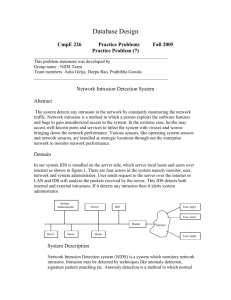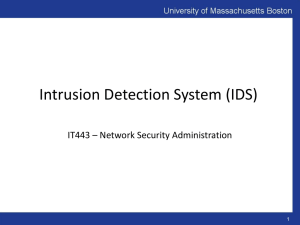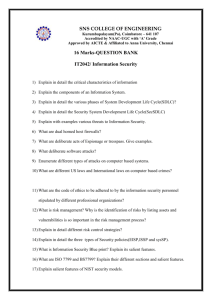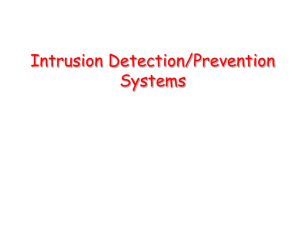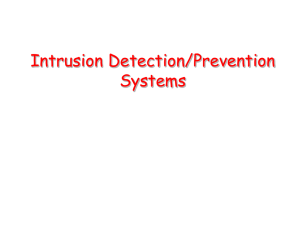Abstract - OpenLoop.com
advertisement
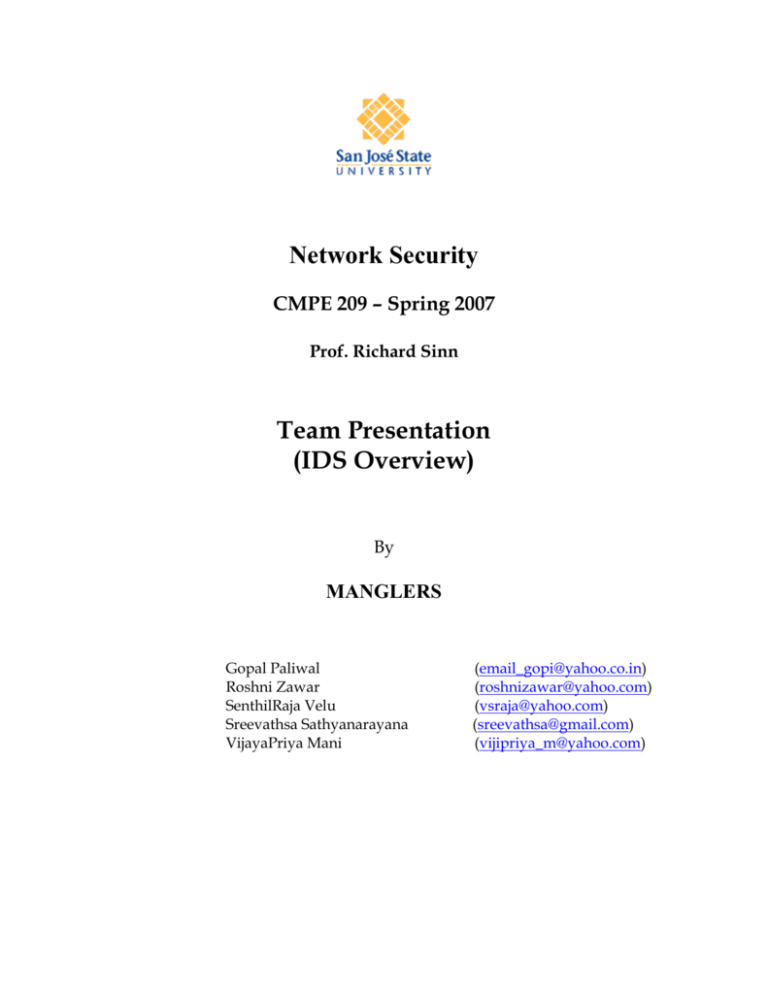
Network Security CMPE 209 – Spring 2007 Prof. Richard Sinn Team Presentation (IDS Overview) By MANGLERS Gopal Paliwal Roshni Zawar SenthilRaja Velu Sreevathsa Sathyanarayana VijayaPriya Mani (email_gopi@yahoo.co.in) (roshnizawar@yahoo.com) (vsraja@yahoo.com) (sreevathsa@gmail.com) (vijipriya_m@yahoo.com) Intrusion Detection System Overview ________________________________________________________________________ Table of contents 1 Abstract ..................................................................................................................... 3 2 Introduction ............................................................................................................. 3 3 Type of IDS .............................................................................................................. 4 3.1 3.2 3.3 4 HOST BASED IDS ................................................................................................ 4 NETWORK BASED IDS ........................................................................................ 4 STACK BASED IDS .............................................................................................. 4 IDS Techniques ......................................................................................................... 5 4.1 4.2 4.3 4.4 SIGNATURE DETECTION ..................................................................................... 5 ANOMALY DETECTION ....................................................................................... 5 TARGET MONITORING ........................................................................................ 5 STEALTH PROBES ................................................................................................ 5 5 Common ID Framework .......................................................................................... 6 6 Snort as a IDS ............................................................................................................ 7 7 Issues with IDS .......................................................................................................... 9 8 Conclusion ................................................................................................................. 9 9 References .................................................................................................................. 9 -2- Intrusion Detection System Overview ________________________________________________________________________ 1 Abstract Intrusion Detection System as the name implies detects intrusion in the network. It implies both intrusions from inside and from outside the network. IDS, these days, have become vital component in the security toolbox. This report and the accompanied presentation and demo provides an overview of IDS, their types, detection techniques employed and various popular IDS tools that are widely used. This report also gives the overview of Snort IDS tool followed by a short demo showing the actual working of snort to catch intrusion based on the rules set. The intent of this presentation and report is to make the audience aware of the importance of IDS and also to make them familiar with the usage of Snort IDS tool. 2 Introduction Intrusion Detection System is any hardware, software, or a combination of both that monitors a system or network of systems against any malicious activity. This is mainly used for detecting break-ins or misuse of the network. In short, we can say that IDS is the ‘burglar alarm’ for the network because much like a burglar alarm, IDS detects the presence of an attack in the network and raises an alert. An IDS provides three functions: monitoring, detecting and generating an alert. IDS are often considered as the functionality of firewall. But there is a thin line of difference between them. A firewall must be regarded as a fence that protects the information flow and prevent intrusions where as IDS detects if the network is under attack or if the security enforced by the firewall has been breached. Together firewall and IDS enhance the security of network. Intrusion Detection System uses a security policy (or rules) to detect unusual activity. These rules are defined by the administrator based on the needs of the organization. Any activity that violates this security policy will be considered a security threat and will be reported to the administrator via email or as page or as SNMP traps. These policies must be updated regularly to keep up with the threats and needs. -3- Intrusion Detection System Overview ________________________________________________________________________ 3 Type of IDS There are three main types of Intrusion Detection Systems: Host Based Network Based Stack Based. 3.1 Host Based IDS Intrusion Detection System is installed on a host in the network. HIDS collects and analyzes the traffic that is originated or is intended to that host. HIDS leverages their privileged access to monitor specific components of a host that are not readily accessible to other systems. Specific components of the operating system such as passwd files in UNIX and the Registry in Windows can be watched for misuse. There is great risk in making these types of components available to NIDS to monitor. Although HIDS is far better than NIDS in detecting malicious activities for a particular host, they have limited view of entire network topology and they cannot detect attack that is targeted for a host in a network which does not have HIDS installed. 3.2 Network Based IDS Network IDSs (NIDS) are placed in key areas of network infrastructure and monitors the traffic as it flows to other host. Unlike HIDS, NIDS have the capability of monitoring the network and detecting the malicious activities intended for that network. Monitoring criteria for a specific host in the network can be increased or decreased with relative ease. NIDS should be capable of standing against large amount number of network traffic to remain effective. As network traffic increases exponentially NIDS must grab all the traffic and analyze in a timely manner. 3.3 Stack Based IDS Stack based IDS is latest technology, which works by integrating closely with the TCP/IP stack, allowing packets to be watched as they traverse their way up the OSI layers. Watching the packet in this way allows the IDS to pull the packet from the stack before the OS or application has a chance to process the packets. -4- Intrusion Detection System Overview ________________________________________________________________________ 4 IDS Techniques 4.1 Signature Detection In this technique known representations of intrusions are stored in the IDS and are then compared to the system activity. When a known intrusion matches these signatures, an alert is raised. Signatures must be created to exactly match the characteristics (protocols or the contents of traffic) of a specific intrusion and no other activities to avoid false positives. This technique is most accurate for detecting known attacks e.g. DoS attack. 4.2 Anomaly Detection Anomaly detection detects a misuse by measuring norm overtime and then generating alert when a pattern differs from a norm. In this technique a set of data is gathered from the system activity of the user and this data set is base lined. If the flow of traffic deviates from the base lined data set pattern an alarm is raised. 4.3 Target Monitoring Target monitoring works by means of generating a cryptographic hash for every file on the system and periodically comparing that hash to the original file to ensure that no change has occurred. This type of system is the easiest to implement, because it does not require constant monitoring by the administrator. Integrity checksum hashes can be computed at whatever intervals we wish on either all files or just the critical files. 4.4 Stealth Probes Stealth probe technique attempts to detect any attackers that choose to carry out their mission over prolonged periods of time. Attackers, for example, will check for system vulnerabilities and open ports over a two-month period, and wait another two months to actually launch the attacks. This technique will collect a wide-variety of data throughout the system, checking for any methodical attacks over a long period of time. They take a wide-area sampling and attempt to discover any correlating attacks. -5- Intrusion Detection System Overview ________________________________________________________________________ 5 Common ID Framework Common ID Framework defines a set of components that are widely used by the existing ID systems. Event Generator (E-Box): The function of the E-box is to provide information about the events to the rest of the IDS. It grabs the event in raw form and makes it available to IDS for further operation on that event. Event Analyzer (A-Box): It mainly analyzes the event which it got from the generator and looks for any potential intrusion activity. Event Database (D-Box): It defines the means for storing data for further analysis over the data. The amount of data generated by E-boxes and A-boxes can be immense and they may require that data in future for further analysis. Response Box (R-Box): This R-box enables the ID system to take appropriate counter measures against the detected intrusion by killing process, resetting the connection etc. -6- Intrusion Detection System Overview ________________________________________________________________________ 6 Snort as a IDS Snort is a light weight open source NIDS, capable of performing real time traffic analysis and packet logging. It performs tasks such as protocol analysis, content search/matching. Snort works in various modes like sniffer mode (acts as protocol analyzer), packet-logger mode (logs the packets in the log file) and NIDS mode. In NIDS mode snort reads the preset rules (or security policies) from the rules file. If any traffic flowing through the network matches these rules then that particular packet gets logged in a log directory. Also at the same time an alert is generated for that particular traffic. Thus any sort of intrusion activity in a network can be monitored. Following is the self-explanatory rules file which we created for our demo: Myrules.rulealert icmp any any -> any any (msg:"ICMP Echo Reply"; itype: 0; icode: 0; sid: 111;) #generates alert for echo reply alert icmp any any -> any any (msg:"ICMP Dest Unreachable "; itype: 3; sid: 112;) #generates alert when destination host is unreachable alert icmp any any -> any any (msg:"ICMP Echo Request"; itype: 8; icode: 0; sid: 113;) #generates alert for a ping(Echo) request alert tcp any any -> any 80 (content: "illegal"; msg: "illegal search alert"; sid: 115;) #generates alert when request is sent to port 80 from home network and that request #contains string “illegal” as a payload alert tcp $TELNET_SERVERS any -> $EXTERNAL_NET 25 (content: "exe"; msg:"TELNET exe content alert"; sid:116;) #generates alert when smtp request content contains exe string as a payload.. alert udp any 53 -> any any (msg:"DNS alert"; content:"|70 69 63 74|";sid:117;) #generates alert when DNS query response(as UDP) is got for a link containing PICT as a string. -7- Intrusion Detection System Overview ________________________________________________________________________ When a snort is run using the above rule file then following packet got logged satisfying rule 2 i.e destination unreachable. Following are the content of log file=+=+=+=+=+=+=+=+=++=+=+=+=+=+=+=+=+=+=+=+=+=+=+=+=+=+=+=+ 04/01-20:40:38.606762 192.168.6.201 -> 192.168.6.200 ICMP TTL:64 TOS:0xC0 ID:38784 IpLen:20 DgmLen:106 Type:3 Code:3 DESTINATION UNREACHABLE: PORT UNREACHABLE ** ORIGINAL DATAGRAM DUMP: 192.168.6.200:137 -> 192.168.6.201:137 UDP TTL:128 TOS:0x0 ID:13352 IpLen:20 DgmLen:78 Len: 50 Csum: 24954 (50 more bytes of original packet) ** END OF DUMP 45 00 00 4E 34 28 00 00 80 11 77 95 C0 A8 06 C8 E..N4(....w..... C0 A8 06 C9 00 89 00 89 00 3A 61 7A CF D2 00 00 .........:az.... 00 01 00 00 00 00 00 00 20 43 4B 41 41 41 41 41 ........ CKAAAAA 41 41 41 41 41 41 41 41 41 41 41 41 41 41 41 41 AAAAAAAAAAAAAAAA 41 41 41 41 41 41 41 41 41 00 00 21 00 01 AAAAAAAAA..!.. =+=+=+=+=+=+=+=+=+=+=+=+=+=+=+=+=+=+=+=+=+=+=+=+=+=+=+=+=+= Below is the alert generated for above request[root@localhost gopal]# cd snort/ [root@localhost snort]# tail -f log/alert [**] [1:112:0] ICMP Dest Unreachable [**] [Priority: 0] 04/01-20:33:54.069488 0:16:D3:A:6C:BF -> 0:15:C5:CA:30:18 type:0x800 len:0x78 192.168.6.201 -> 192.168.6.200 ICMP TTL:64 TOS:0xC0 ID:38778 IpLen:20 DgmLen:106 Type:3 Code:3 DESTINATION UNREACHABLE: PORT UNREACHABLE ** ORIGINAL DATAGRAM DUMP: Thus, snort comes out to be an excellent tool in monitoring a network against malicious activity. -8- Intrusion Detection System Overview ________________________________________________________________________ 7 Issues with IDS Although IDS is not a new idea, it is not yet fully mature and researched technology. It has some limitations which include, Generating too much ‘false positive’ alerts. An administrator may dismiss real attack as another false alarm, in effect, negating the function of an IDS. IDS output a large amount of audit data that must be analyzed and examined by human operators in detecting instructions and misuses. In IDS it is difficult to constantly configure and update security rules. Network based IDS is unreliable on high-speed and switched networks. 8 Conclusion An IDS is not a security panacea but it is a good warning system. It can detect attacks in near real-time, alert an administrator as attacks are happening and expose an hacker’s technique. 9 References Book: Intrusion detection system with snort by Jack koziol Snort IDS (www.snort.org) Intrusion Detection Systems (www.certiguide.com/secplus/cg_sp_34IntrustionDetectionSystem.htm) An introduction to IDS (http://www.securityfocus.com/infocus/1520) Intrusion Detection FAQ: Why is intrusion detection required in today’s computing environment? (http://www.sans.org/resources/idfaq/id_required.php? IDS, what is it and why do we need it? (http://www.ixact.ch/english/pagesnav/IN.htm) -9-


